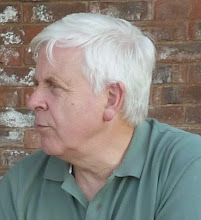 I introduced this as a topic for our (face-to-face) reading group partly because I'm interested in the theory of object-centred sociality but also because I wanted to see whether talking about a blog post would be different from discussing a journal article, which is what we usually do in the reading group. This seemed to me to be relevant to our ongoing consideration of what is involved in digital scholarship.
I introduced this as a topic for our (face-to-face) reading group partly because I'm interested in the theory of object-centred sociality but also because I wanted to see whether talking about a blog post would be different from discussing a journal article, which is what we usually do in the reading group. This seemed to me to be relevant to our ongoing consideration of what is involved in digital scholarship. In the event, I thought it was a different kind of discussion, although I'm not sure my colleagues agreed with me.
For a start, the presence of the text itself was ambiguous. Usually everyone prints out the article & sits around in a circle holding it in front of them. In this case, one or two people had printed it out, a couple had it on their laptops (although not necessarily open in front of them), another had it on his phone, another didn't have it at all (although they said they had read it.) It all felt a bit ephemeral to me, with some of the more extended features of the text (its links out, its later follow-up postings etc.) not present at all even when they were being discussed.
And then, I felt that the discussion was more reflexive than usual – with people talking more about their own experiences with social media rather than about what Engestrom might be saying about Knor Cetina's theory, or what the commenters might be saying about Engestrom's views.
Lots of interesting points were raised however: the relation between links in a blog post and references in an academic article; the effects on the persistent text of its links becoming broken over time; knowing where the boundaries of a blog text actually finish...
On the issue of digital scholarship, it seemed to down to whether we see Engestrom's post as a kind of mini-example of 'good ' conventional scholarship (well-researched, concisely structured and expressed, appropriately referenced etc.) or whether we are prepared to take the whole set of connected texts (comments, linked sites follow-up texts) as representing a different kind of, more collaborative, scholarship.
Whilst I'm broadly in favour of the latter view, my problem with it in this case is what has happened to Knorr-Cetina's principled notion of 'objects of sociality' in the translation from Engestrom's invoking of it to account for the failure of some social networking practices in 2005 (45 citations in Google scholar), to, for example, Hugh McLeod's distinctly non-scholarly appropriation of it to publicise his artwork 2 years later (2950 hits on Google).
Reading through the 100 comments on Engestrom's post I only managed to find two that referred back to Knorr-Cetina. Most of the other constructive ones ran with the issue of what makes social networking successful or otherwise, without really bothering whether it might be evidence of a 'post-social' turn in contemporary social life or not! Understandable it may be, but rather more digital than scholarly I thought.
****************************
Some notes on Engestrom's post:
This was prompted by a blog post from Russell Beattie http://www.russellbeattie.com/blog/1008411 explaining that he had decided to close his LinkedIn account because he had too many contacts and nothing to say to any of them, and the system would have required him to delete them individually.
E. claims there is a 'profound confusion about the nature of sociality' due to the use of the term social network to refer to a 'map of the relationships between individuals’.
He proposes an alternative approach to social networks – based on Knorr Cetina - and sets out to explain how this approach accounts for why some social networking services succeed while others don't.
Summary of comments:
| Content topic | No. of comments |
| Google Maps, Flickr and Camera Phones as an infrastructure for new location-centred social software | 7 |
| Open question/development of original topic | 28 |
| General approval/re-blog | 20 |
| Own site/blog/talks/promotions | 24 |
| Trackbacks | 5 |
| Critical | 7 |
| Personal | 2 |
| Misc/irrelevant/spam | 18 |
| Responses from JE | 1 |
Google search: Jyri Engeström "the case for object-centered sociality" -site:www.zengestrom.com/
Approx 2760 results (in all languages), 1930 in English
June 10, 2005 –announcing his talk on object centred sociality at Reboot conference in Copenhagen (links to summaries on David Weinberger's blog, Bohellz blog, PowerPoint and PDF no longer work).
19 comments on this post: http://www.zengestrom.com/blog/2005/06/speaking-on-object-centered-sociality-at-reboot-updated-with-slides.html#comments
December 3, 2006 – announcing his talk at the MSN-sponsored Innovate event in Stockholm, on social objects (link broken).
3 comments on this post: http://www.zengestrom.com/blog/2006/12/social-objects-talk-in-stockholm.html#comments
September 17, 2007 – comment on cartoonist Hugh MacLeod on wine as a social object with reference to a label created for Microsoft and its employees. Link to MacLeod's website (May 18, 2008) 'Free cartoons as social objects http://www.gapingvoid.com/Moveable_Type/archives/cat_microsoft_blue_monster_series.html
10 comments
February 13, 2010 – another message about Hugh MacLeod on social objects for beginners (from 2007) (http://gapingvoid.com/2007/12/31/social-objects-for-beginners/)
6 comments

